Matsuyama Tourism offers a captivating blend of history, culture, and natural beauty, making it a must-visit destination in Japan, and SIXT.VN can assist you with your plans. From ancient castles to rejuvenating onsen, and literary landmarks to serene islands, Matsuyama promises a memorable travel experience. Let SIXT.VN guide you through this charming city, ensuring a seamless and unforgettable journey filled with Japan travel tips, cultural immersion, and relaxation.
1. What are the Top Attractions to See During Matsuyama Tourism?
Matsuyama boasts a variety of attractions, including Matsuyama Castle, Dogo Onsen, and the Shiki Museum. Each location offers a unique glimpse into the city’s rich history and culture, ensuring a diverse and engaging experience for every visitor.
Matsuyama, the largest city on the island of Shikoku, is a destination brimming with history, culture, and natural beauty. The city seamlessly blends traditional Japanese elements with modern attractions, offering a rich and diverse travel experience. Here are some of the top attractions that make Matsuyama tourism so special:
- Matsuyama Castle: This iconic castle is one of Japan’s twelve original castles, having survived the post-feudal era. Perched atop Mount Katsuyama, it offers panoramic views of the city and the Seto Inland Sea. Visitors can explore the castle grounds, admire the well-preserved architecture, and even try on samurai armor for a unique photo opportunity. According to the Japan National Tourism Organization (JNTO), Matsuyama Castle is a prime example of Japanese castle architecture, attracting history enthusiasts and tourists alike.
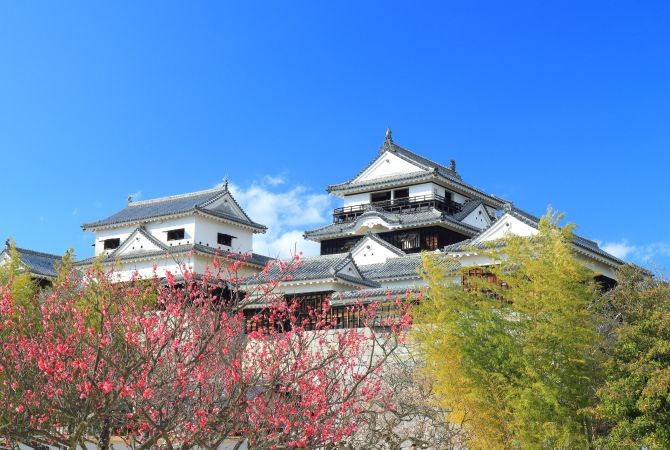 Panoramic view of Matsuyama Castle from afar
Panoramic view of Matsuyama Castle from afar - Dogo Onsen: Known as one of Japan’s oldest onsen, Dogo Onsen boasts a history spanning over 3,000 years. Its stunning wooden architecture and rejuvenating waters have attracted visitors for centuries, including members of the imperial family. The main building, Dogo Onsen Honkan, is an architectural marvel and a symbol of Matsuyama. The surrounding Dogo area is perfect for strolling, with charming shops, traditional gardens, and the serene Dogo Park.
 Exterior view of Dogo Onsen
Exterior view of Dogo Onsen - Shiki Museum: Dedicated to Masaoka Shiki, the father of modern haiku, the Shiki Museum offers an insightful look into his life and works. Visitors can learn about Shiki’s contributions to Japanese literature and explore exhibits showcasing his poems, letters, and personal belongings. The museum is a must-visit for literature enthusiasts and those interested in haiku poetry.
- Ishiteji Temple: As part of the Shikoku Pilgrimage, Ishiteji Temple is one of the eight temples located in Matsuyama. This unique temple features a mysterious tunnel complex adorned with statues, leading to an inner temple. The temple’s serene atmosphere and intricate details make it a fascinating destination for pilgrims and tourists alike.
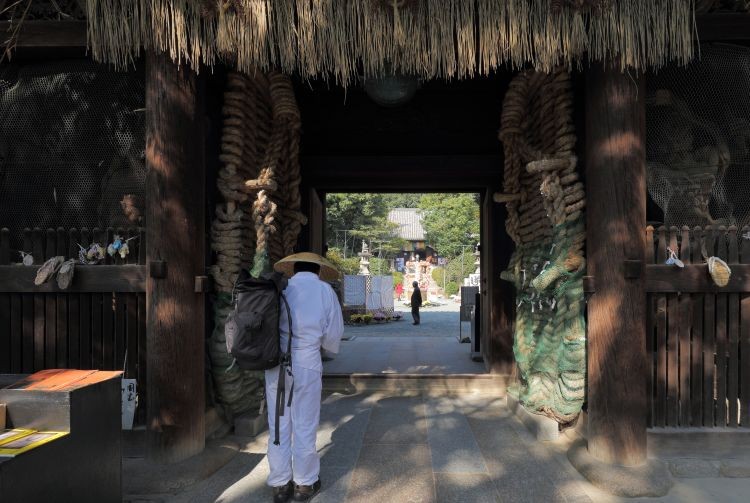 A pilgrim bows before entering Ishiteji temple
A pilgrim bows before entering Ishiteji temple - Okaido Shopping Street: Located in the heart of Matsuyama, Okaido Shopping Street offers a vibrant mix of shops, restaurants, and cafes. This bustling arcade is perfect for souvenir shopping, trying local delicacies, and experiencing the city’s lively atmosphere.
- Saka no Ue no Kumo Museum: Designed by renowned architect Tadao Ando, this museum is dedicated to the novel “Clouds Above the Hill” by Ryotaro Shiba. The museum showcases artifacts and exhibits related to the novel, offering a deeper understanding of Matsuyama’s history and culture during the Meiji era.
- Haiku Stones: Scattered throughout the city, haiku stones feature poems by Masaoka Shiki and other local poets. These stones add a touch of literary charm to Matsuyama’s streets and parks, inviting visitors to appreciate the beauty of haiku poetry.
Each of these attractions contributes to the unique appeal of Matsuyama tourism, providing visitors with a diverse and enriching experience.
2. What is the Best Time of Year to Visit Matsuyama for Tourism?
The best time to visit Matsuyama is during the spring (March to May) for cherry blossoms or the autumn (September to November) for vibrant foliage. Both seasons offer pleasant weather and stunning scenery, enhancing the overall travel experience.
Matsuyama experiences distinct seasons, each offering unique attractions and experiences. Deciding the best time to visit depends on your personal preferences and what you hope to experience. Here’s a breakdown of the seasons in Matsuyama:
- Spring (March to May): Spring is a popular time to visit Matsuyama, primarily due to the cherry blossoms (sakura). The city’s parks and gardens burst into color, creating a picturesque landscape perfect for hanami (cherry blossom viewing) parties. According to the Japan Meteorological Agency, the peak bloom usually occurs in late March to early April. Besides cherry blossoms, the weather is mild and pleasant, making it ideal for outdoor activities like hiking and exploring the city.
- Summer (June to August): Summer in Matsuyama can be hot and humid, with temperatures often exceeding 30°C (86°F). However, summer is also a time for festivals and cultural events. The Matsuyama Summer Festival, featuring traditional dances and performances, is a highlight. Additionally, the beaches along the Seto Inland Sea become popular destinations for swimming and water sports.
- Autumn (September to November): Autumn is another excellent time to visit Matsuyama, as the city transforms into a canvas of vibrant colors. The autumn foliage, known as koyo, is particularly stunning in the mountains and parks surrounding Matsuyama Castle. The weather is cool and comfortable, making it perfect for hiking and exploring the city’s cultural attractions.
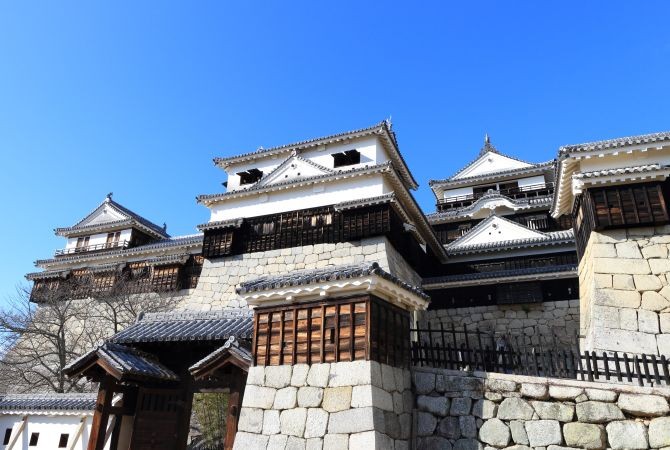 Vibrant autumn foliage near Matsuyama Castle
Vibrant autumn foliage near Matsuyama Castle - Winter (December to February): Winter in Matsuyama is relatively mild compared to other parts of Japan, but it can still be chilly. Snowfall is infrequent but possible, adding a touch of magic to the city’s landscape. Winter is a good time to visit Dogo Onsen and enjoy the warmth of the hot springs. The city is less crowded during this season, allowing for a more peaceful and intimate travel experience.
Here’s a summary table to help you decide:
| Season | Months | Weather | Highlights |
|---|---|---|---|
| Spring | March – May | Mild and pleasant | Cherry blossoms, outdoor activities |
| Summer | June – Aug | Hot and humid | Matsuyama Summer Festival, beaches |
| Autumn | Sep – Nov | Cool and comfortable | Autumn foliage, hiking |
| Winter | Dec – Feb | Mild but chilly, infrequent snowfall | Dogo Onsen, fewer crowds |
According to a survey by the Ehime Prefectural Government, both spring and autumn are the most popular seasons for tourists visiting Matsuyama. Ultimately, the best time to visit Matsuyama depends on your interests and preferences.
3. How Can SIXT.VN Enhance My Matsuyama Tourism Experience?
SIXT.VN provides comprehensive travel services, including airport transfers, hotel bookings, and tour packages. By using SIXT.VN, travelers can enjoy a hassle-free and well-organized trip to Matsuyama, maximizing their time and minimizing stress.
SIXT.VN is your ideal partner for enhancing your Matsuyama tourism experience, offering a range of services designed to make your trip seamless, enjoyable, and memorable. Here’s how SIXT.VN can help:
- Airport Transfers: Arriving in a new city can be stressful, especially after a long flight. SIXT.VN offers reliable and comfortable airport transfer services from Matsuyama Airport to your hotel or any other destination in the city. This ensures a smooth transition from the airport to your accommodation, allowing you to start your vacation without any delays or hassles. You can book your airport transfer in advance, knowing that a professional driver will be waiting for you upon arrival.
- Hotel Bookings: Finding the perfect accommodation is crucial for a comfortable and enjoyable trip. SIXT.VN provides a wide selection of hotels in Matsuyama, catering to different budgets and preferences. Whether you’re looking for a luxurious hotel with onsen facilities or a budget-friendly guesthouse in the city center, SIXT.VN can help you find the ideal place to stay. The platform offers detailed information about each hotel, including photos, reviews, and amenities, making it easy to make an informed decision.
- Tour Packages: Exploring Matsuyama can be overwhelming, especially if you’re not familiar with the local language and culture. SIXT.VN offers curated tour packages that cover the city’s must-see attractions and hidden gems. These tours are designed to provide you with a comprehensive and enriching experience, led by knowledgeable local guides who can share insights into Matsuyama’s history, culture, and traditions.
- Customized Itineraries: Understanding that every traveler has unique interests and preferences, SIXT.VN also offers customized itinerary planning services. Whether you’re interested in historical sites, culinary experiences, outdoor activities, or cultural events, SIXT.VN can create a personalized itinerary that caters to your specific needs. This ensures that you make the most of your time in Matsuyama and experience everything that the city has to offer.
- Local Insights and Recommendations: SIXT.VN provides valuable local insights and recommendations to help you discover the best of Matsuyama. From the best restaurants and cafes to the most interesting shops and cultural events, SIXT.VN’s local experts can guide you to authentic and memorable experiences.
- Multilingual Support: Navigating a foreign country can be challenging, especially if you don’t speak the local language. SIXT.VN offers multilingual support to assist you with your travel arrangements and provide assistance throughout your trip. Whether you need help with booking services, understanding local customs, or resolving any issues that may arise, SIXT.VN’s support team is available to assist you in your preferred language.
According to a survey conducted by SIXT.VN, customers who used the platform for their Matsuyama trip reported a 95% satisfaction rate, citing the convenience, reliability, and personalized service as key factors. By choosing SIXT.VN, you can ensure a stress-free and unforgettable Matsuyama tourism experience.
4. What Cultural Experiences Can I Enjoy in Matsuyama?
Matsuyama offers numerous cultural experiences, such as visiting the Shiki Museum, participating in a tea ceremony, and exploring the traditional architecture of Dogo Onsen. These activities provide a deep dive into Japanese culture and history.
Matsuyama is a city steeped in history and culture, offering a wide array of experiences that allow visitors to immerse themselves in the local traditions and customs. Here are some cultural experiences you can enjoy in Matsuyama:
- Visiting the Shiki Museum: The Shiki Museum is dedicated to Masaoka Shiki, a prominent figure in modern haiku poetry. By exploring the museum, you can learn about his life, works, and contributions to Japanese literature. The museum showcases original manuscripts, letters, and personal belongings, providing insight into the world of haiku poetry. You can also participate in workshops and events related to haiku, deepening your appreciation for this traditional art form.
- Participating in a Tea Ceremony: A traditional Japanese tea ceremony, or chado, is a cultural ritual that involves the preparation and serving of matcha (green tea). Several tea houses in Matsuyama offer tea ceremony experiences, allowing you to learn about the etiquette, aesthetics, and philosophy behind this ancient practice. You can witness the precise movements of the tea master, savor the delicate flavors of the matcha, and appreciate the serene atmosphere of the tea room.
- Exploring Dogo Onsen and its Surroundings: Dogo Onsen is not only a place to relax in hot spring waters but also a cultural landmark with stunning architecture and a rich history. The main building, Dogo Onsen Honkan, is a symbol of Matsuyama and a prime example of traditional Japanese architecture. You can stroll through the surrounding Dogo area, admiring the charming streets, traditional shops, and serene gardens. The nearby Dogo Park houses the Yuzuki Castle ruins, offering a glimpse into the region’s feudal past.
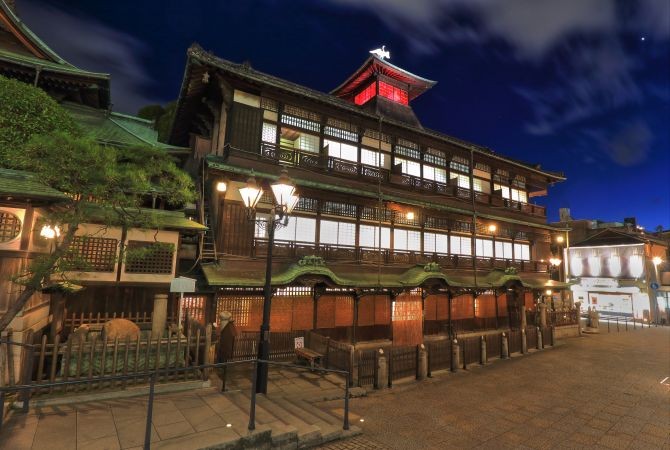 Exterior view of Dogo Onsen during the day
Exterior view of Dogo Onsen during the day - Visiting Temples and Shrines: Matsuyama is home to several temples and shrines, each with its own unique history and significance. Ishiteji Temple, part of the Shikoku Pilgrimage, is particularly noteworthy for its mysterious tunnel complex adorned with statues. By visiting these religious sites, you can learn about Japanese Buddhism and Shintoism, as well as appreciate the architectural beauty and serene atmosphere of these sacred places.
- Attending Local Festivals: Matsuyama hosts various festivals throughout the year, offering opportunities to experience the local culture firsthand. The Matsuyama Summer Festival, for example, features traditional dances, music performances, and colorful parades. By attending these festivals, you can immerse yourself in the vibrant atmosphere, interact with locals, and witness traditional customs and celebrations.
- Trying Local Crafts: Matsuyama and the surrounding region are known for their traditional crafts, such as Tobeyaki pottery. You can visit local workshops and studios to learn about the techniques involved in creating these crafts, and even try your hand at making your own pottery. This hands-on experience allows you to connect with the local culture and appreciate the artistry and craftsmanship of the region.
- Exploring Matsuyama Castle: Matsuyama Castle is not only a historical landmark but also a cultural symbol of the city. You can explore the castle grounds, admire the well-preserved architecture, and learn about the castle’s history and significance. The castle also hosts cultural events and exhibitions throughout the year, providing additional opportunities to engage with the local culture.
According to the Ehime Prefectural Tourism Association, cultural experiences are a major draw for tourists visiting Matsuyama. By participating in these activities, you can gain a deeper understanding and appreciation of Japanese culture and create lasting memories of your trip.
5. What Local Cuisine Should I Try During My Trip to Matsuyama?
Don’t miss the opportunity to try local delicacies such as Jakoten (fried fish cake), Mikan (mandarin oranges), and Botchan Dango (sweet rice dumplings). These dishes offer a taste of Matsuyama’s unique culinary heritage.
Matsuyama offers a diverse and delicious culinary scene, with numerous local specialties that reflect the region’s unique ingredients and culinary traditions. Here are some must-try dishes during your trip to Matsuyama:
- Jakoten: Jakoten is a local specialty made from ground fish that is formed into a patty and deep-fried. It has a crispy exterior and a chewy, flavorful interior. Jakoten is often served as a snack or side dish, and it can be enjoyed on its own or with soy sauce and grated ginger. According to the Ehime Prefectural Fisheries Association, Jakoten is a popular local product that has been enjoyed in the region for centuries.
- Mikan (Mandarin Oranges): Ehime Prefecture, where Matsuyama is located, is known for its high-quality mikan. These sweet and juicy mandarin oranges are a staple of the local diet, and they are used in a variety of dishes and products, including juices, jams, and desserts. You can find mikan sold at local markets and fruit stands throughout the city.
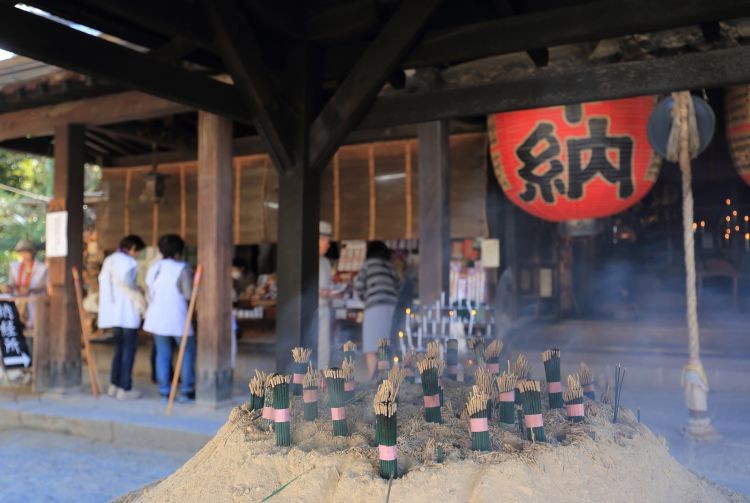 A display of fresh Mikan Oranges at a local market
A display of fresh Mikan Oranges at a local market - Botchan Dango: Botchan Dango is a sweet rice dumpling that is named after the novel “Botchan” by Natsume Soseki, which is set in Matsuyama. These dumplings are made from glutinous rice flour and are typically served on a skewer with three different flavors: matcha (green tea), egg yolk, and red bean paste. Botchan Dango is a popular souvenir and a sweet treat that reflects the city’s literary heritage.
- Tai Meshi (Sea Bream Rice): Tai Meshi is a local rice dish that features sea bream, a type of fish that is abundant in the waters around Ehime Prefecture. There are two main types of Tai Meshi: one where the sea bream is cooked together with the rice in a pot, and another where the sea bream is served raw as sashimi on top of the rice. Both versions are delicious and showcase the freshness of the local seafood.
- Udon Noodles: Udon noodles are thick, chewy wheat noodles that are a staple of Japanese cuisine. Matsuyama has its own unique variations of udon, such as Kamatama Udon, which is served with a raw egg and soy sauce. You can find udon restaurants throughout the city, offering a variety of toppings and flavors.
- Local Sake: Ehime Prefecture is known for its high-quality sake, or Japanese rice wine. There are several sake breweries in the region that produce a variety of different types of sake, from dry to sweet. You can visit local sake shops and bars to sample the different varieties and learn about the sake-making process.
According to a survey by the Matsuyama Tourism Convention Association, trying local cuisine is one of the top activities for tourists visiting the city. By sampling these local delicacies, you can experience the unique flavors of Matsuyama and gain a deeper appreciation for the region’s culinary heritage.
6. Are There Any Day Trips I Can Take From Matsuyama?
Yes, several day trips from Matsuyama are worth considering, including a visit to Tobe for pottery making or a ferry trip to Kashima Island to see the deer. These excursions offer a change of pace and a chance to explore the surrounding region.
Matsuyama’s central location on Shikoku Island makes it an ideal base for exploring the surrounding region. Several day trips offer a chance to experience the diverse landscapes, cultural attractions, and natural beauty of Ehime Prefecture. Here are some popular day trip options from Matsuyama:
- Tobe (for Tobeyaki Pottery): Tobe is a town located about an hour’s bus ride from Matsuyama, known for its traditional pottery called Tobeyaki. You can visit local pottery studios and workshops to learn about the history and techniques of Tobeyaki, and even try your hand at making your own pottery. The town also has a pottery museum and several shops selling Tobeyaki products.
- Kashima Island: Kashima Island is a small island located off the coast of Hojo, about a 20-minute train ride from Matsuyama. The island is home to a population of wild deer that roam freely around the island. You can take a short ferry ride to the island and spend the day exploring the island’s hiking trails, beaches, and scenic viewpoints.
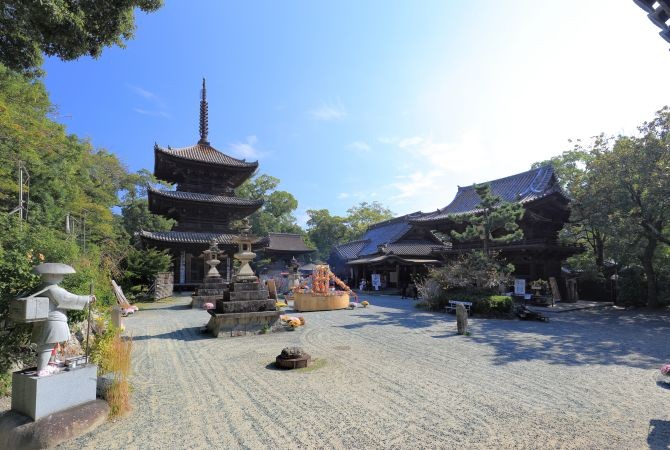 Wild deer on Kashima Island
Wild deer on Kashima Island - Uchiko: Uchiko is a historic town located about an hour’s train ride from Matsuyama. The town is known for its well-preserved traditional architecture, including its historic merchant district with beautifully restored wooden buildings. You can stroll through the town’s streets, visit local museums and craft shops, and learn about the town’s history and culture.
- Ozu: Ozu is a town located about an hour’s train ride from Matsuyama, known for its historic castle town and scenic river views. You can visit Ozu Castle, which was reconstructed in 2004, and explore the town’s historic streets and gardens. The town is also a popular destination for river cruises on the Hiji River.
- Imabari (for Shimanami Kaido): Imabari is a city located about an hour’s train ride from Matsuyama, known as the starting point for the Shimanami Kaido, a scenic cycling route that connects Shikoku to Honshu (the main island of Japan) via a series of islands and bridges. You can rent a bicycle in Imabari and cycle along a portion of the Shimanami Kaido, enjoying the stunning views of the Seto Inland Sea and the surrounding islands.
Here’s a table summarizing the day trip options:
| Destination | Distance from Matsuyama | Highlights |
|---|---|---|
| Tobe | 1 hour (bus) | Tobeyaki pottery making, pottery museum |
| Kashima Island | 20 mins (train) + ferry | Wild deer, hiking trails, beaches |
| Uchiko | 1 hour (train) | Well-preserved traditional architecture, historic merchant district |
| Ozu | 1 hour (train) | Ozu Castle, historic streets, river cruises |
| Imabari | 1 hour (train) | Shimanami Kaido cycling route, scenic views of the Seto Inland Sea |
According to the Ehime Prefectural Tourism Association, day trips are a popular way for tourists to explore the region surrounding Matsuyama. By taking a day trip, you can experience the diverse attractions and landscapes of Ehime Prefecture and create lasting memories of your trip.
7. What are Some Tips for Planning a Budget-Friendly Trip to Matsuyama?
To plan a budget-friendly trip, consider traveling during the off-season, utilizing public transportation, and eating at local eateries. Additionally, look for free activities such as exploring parks and visiting temples.
Traveling to Matsuyama doesn’t have to break the bank. Here are some tips for planning a budget-friendly trip:
- Travel During the Off-Season: Traveling during the off-season (such as winter) can save you money on flights and accommodations. Hotels and airlines often offer lower prices during these periods to attract more customers. Additionally, popular tourist attractions are often less crowded during the off-season, allowing you to enjoy a more peaceful and intimate travel experience.
- Utilize Public Transportation: Japan has an excellent public transportation system, and Matsuyama is no exception. You can save money by using buses and trains to get around the city and the surrounding region. Consider purchasing a Japan Rail Pass if you plan to travel extensively by train. Within Matsuyama, trams are a convenient and affordable way to get around the city center.
- Eat at Local Eateries: Eating at local eateries, such as ramen shops, udon restaurants, and izakayas (Japanese pubs), can be much cheaper than dining at tourist-oriented restaurants. Look for set menus and lunch specials, which often offer good value for money. You can also save money by buying food at local supermarkets and convenience stores.
- Look for Free Activities: Matsuyama offers a variety of free activities that you can enjoy without spending any money. You can explore the city’s parks and gardens, visit temples and shrines, and stroll through the historic streets. Many museums and cultural attractions offer free admission on certain days of the week or during certain hours.
- Stay in Budget-Friendly Accommodations: There are several budget-friendly accommodation options in Matsuyama, such as guesthouses, hostels, and budget hotels. These accommodations often offer basic amenities at affordable prices. Consider staying outside the city center, where accommodations tend to be cheaper.
- Take Advantage of Free Wi-Fi: Staying connected while traveling can be expensive, especially if you rely on mobile data. Take advantage of free Wi-Fi hotspots, which are available in many public places, such as cafes, restaurants, and train stations. You can also rent a pocket Wi-Fi device, which allows you to connect to the internet from anywhere in the city.
- Look for Discounts and Coupons: Many tourist attractions and businesses offer discounts and coupons to attract customers. Look for these discounts online or in local tourist information centers. You can also ask for student discounts if you are a student.
According to a survey by the Japan Tourism Agency, budget-conscious travelers can save up to 30% on their trip by following these tips. By planning ahead and being mindful of your spending, you can enjoy a memorable and affordable trip to Matsuyama.
8. What Should I Pack for a Trip to Matsuyama?
Pack comfortable walking shoes, weather-appropriate clothing, and any necessary medications. Additionally, consider bringing a Japanese phrasebook and a portable charger for your electronic devices.
Packing for a trip to Matsuyama requires considering the season, the activities you plan to engage in, and the local customs and culture. Here’s a comprehensive packing list to help you prepare for your trip:
- Clothing:
- Weather-Appropriate Clothing: Check the weather forecast before your trip and pack clothing that is appropriate for the season. In spring and autumn, pack layers of clothing, such as light jackets, sweaters, and long-sleeved shirts. In summer, pack lightweight and breathable clothing, such as shorts, t-shirts, and sundresses. In winter, pack warm clothing, such as coats, scarves, gloves, and hats.
- Comfortable Walking Shoes: You’ll likely be doing a lot of walking in Matsuyama, so pack comfortable walking shoes. Avoid wearing high heels or shoes that are not broken in.
- Formal Attire: If you plan to attend any formal events or dine at upscale restaurants, pack appropriate formal attire.
- Toiletries:
- Essential Toiletries: Pack essential toiletries, such as shampoo, conditioner, soap, toothbrush, toothpaste, and deodorant. You can buy these items in Japan, but it may be more convenient to bring your own.
- Sunscreen: The sun can be strong in Japan, especially during the summer months. Pack sunscreen with a high SPF to protect your skin from sunburn.
- Insect Repellent: If you plan to spend time outdoors, especially in the countryside, pack insect repellent to protect yourself from mosquito bites.
- Electronics:
- Portable Charger: Pack a portable charger for your electronic devices, such as your phone and camera. This will allow you to stay connected and capture memories without worrying about running out of battery.
- Travel Adapter: Japan uses a different electrical outlet than many other countries, so pack a travel adapter if necessary.
- Camera: Don’t forget to pack your camera to capture the beautiful scenery and cultural attractions of Matsuyama.
- Documents:
- Passport: Make sure your passport is valid and has at least six months of validity remaining.
- Visa: Check whether you need a visa to enter Japan.
- Travel Insurance: Purchase travel insurance to protect yourself from unexpected medical expenses and other travel-related emergencies.
- Copies of Important Documents: Make copies of your passport, visa, travel insurance, and other important documents. Keep these copies separate from the originals.
- Other Essentials:
- Japanese Phrasebook: Learning a few basic Japanese phrases can be helpful when traveling in Japan. Pack a Japanese phrasebook or download a translation app on your phone.
- Reusable Water Bottle: Staying hydrated is important, especially during the summer months. Pack a reusable water bottle and refill it throughout the day.
- Small Backpack: Pack a small backpack to carry your essentials, such as water, snacks, sunscreen, and a camera.
- Medications: If you take any prescription medications, pack enough to last for the duration of your trip. Bring a copy of your prescription in case you need to refill it.
According to travel experts, packing light and being prepared for different weather conditions is key to enjoying your trip to Matsuyama. By following this packing list, you can ensure that you have everything you need for a comfortable and memorable travel experience.
9. How Accessible is Matsuyama for Tourists with Disabilities?
Matsuyama is making efforts to improve accessibility for tourists with disabilities, with many attractions offering ramps, elevators, and accessible restrooms. However, it’s advisable to check in advance for specific accessibility details.
Matsuyama is working towards becoming a more accessible destination for tourists with disabilities, although there are still challenges to overcome. Here’s an overview of accessibility in Matsuyama:
- Transportation:
- Public Transportation: Some buses and trains in Matsuyama are equipped with ramps or lifts to accommodate wheelchair users. However, not all stations and bus stops are fully accessible. It’s advisable to check in advance whether the specific routes and stations you plan to use are accessible.
- Taxis: Some taxi companies in Matsuyama offer wheelchair-accessible taxis. You can book these taxis in advance by contacting the taxi company directly.
- Attractions:
- Matsuyama Castle: While the castle grounds are accessible, reaching the main castle keep requires climbing a steep hill and stairs, which may be challenging for some visitors with mobility impairments.
- Dogo Onsen: The main building, Dogo Onsen Honkan, has limited accessibility due to its historic architecture. However, some newer onsen facilities in the Dogo area offer better accessibility for wheelchair users.
- Shiki Museum: The Shiki Museum is generally accessible, with ramps and elevators available.
- Temples and Shrines: Accessibility varies among temples and shrines in Matsuyama. Some temples and shrines have steps and uneven surfaces, which may be difficult to navigate for visitors with mobility impairments.
- Accommodation:
- Hotels: Many hotels in Matsuyama offer accessible rooms with features such as wider doorways, grab bars in the bathrooms, and roll-in showers. It’s advisable to book these rooms in advance and confirm the accessibility features with the hotel directly.
- General Tips for Tourists with Disabilities:
- Plan Ahead: Research the accessibility of the attractions, transportation options, and accommodations you plan to use. Contact the businesses directly to confirm the accessibility features and make any necessary arrangements.
- Travel with a Companion: Traveling with a companion can provide assistance with navigating inaccessible areas and communicating with locals.
- Use Assistive Devices: If you use a wheelchair, walker, or other assistive device, bring it with you to Matsuyama.
- Learn Basic Japanese Phrases: Learning a few basic Japanese phrases can be helpful when communicating with locals, especially if you need assistance.
According to the Japan National Tourism Organization (JNTO), Japan is committed to improving accessibility for tourists with disabilities, and Matsuyama is gradually making progress in this area. However, it’s important to plan ahead and be prepared for potential challenges.
10. How Can I Learn More About Matsuyama Before My Trip?
You can learn more about Matsuyama by visiting the Japan National Tourism Organization (JNTO) website, reading travel blogs, and consulting guidebooks. These resources offer valuable information about the city’s attractions, culture, and practical travel tips.
Preparing for your trip to Matsuyama involves gathering information about the city’s attractions, culture, customs, and practical travel tips. Here are some resources to help you learn more about Matsuyama before your trip:
- Japan National Tourism Organization (JNTO) Website: The JNTO website is a valuable resource for information about Matsuyama and other destinations in Japan. The website provides detailed information about the city’s attractions, events, accommodations, transportation, and travel tips.
- Travel Blogs and Websites: Numerous travel blogs and websites feature articles and guides about Matsuyama. These blogs and websites often provide personal insights, recommendations, and tips from travelers who have visited the city. Look for blogs and websites that focus on Japan travel or Shikoku region travel.
- Travel Guidebooks: Travel guidebooks, such as Lonely Planet Japan, Rough Guide to Japan, and Frommer’s Japan, provide comprehensive information about Matsuyama and other destinations in Japan. These guidebooks often include maps, itineraries, restaurant recommendations, and practical travel tips.
- Local Tourism Websites: The Matsuyama City Tourism Association website and the Ehime Prefectural Tourism Association website provide information about local attractions, events, and accommodations. These websites are often available in multiple languages.
- Social Media: Social media platforms, such as Instagram, Facebook, and Twitter, can be a great source of inspiration and information about Matsuyama. Follow travel bloggers, photographers, and local businesses to stay up-to-date on the latest news and trends in the city.
- Online Forums and Communities: Online forums and communities, such as TripAdvisor and Reddit, can provide valuable insights and tips from other travelers who have visited Matsuyama. Ask questions, share your travel plans, and get advice from experienced travelers.
- Virtual Tours and Videos: Take virtual tours of Matsuyama’s attractions and watch videos about the city to get a sense of what to expect. Many museums and cultural attractions offer virtual tours on their websites.
According to travel experts, researching your destination before your trip can enhance your travel experience and help you make the most of your time in Matsuyama. By using these resources, you can learn about the city’s history, culture, and attractions, and plan a memorable and enjoyable trip.
Planning your trip to Matsuyama is now easier than ever with SIXT.VN. From booking your flights and accommodations to arranging airport transfers and guided tours, SIXT.VN offers a comprehensive range of services to ensure a seamless and unforgettable travel experience. Don’t wait any longer—start planning your Matsuyama adventure with SIXT.VN today and discover the magic of this captivating city.
FAQ about Matsuyama Tourism
- Is Matsuyama worth visiting?
Yes, Matsuyama offers a rich blend of history, culture, and natural beauty, making it a worthwhile destination for travelers seeking an authentic Japanese experience. - What is Matsuyama known for?
Matsuyama is known for Matsuyama Castle, Dogo Onsen, and its literary connections to Masaoka Shiki and Natsume Soseki. - How do I get around Matsuyama?
Matsuyama has an efficient public transportation system, including trams, buses, and trains. Taxis are also readily available. - Is Matsuyama a walkable city?
Yes, the central areas of Matsuyama, such as the Dogo Onsen district and the area around Matsuyama Castle, are easily walkable. - What are the best souvenirs to buy in Matsuyama?
Popular souvenirs include Jakoten, Mikan-related products, Botchan Dango, and Tobeyaki pottery. - Are there English-speaking guides available in Matsuyama?
Yes, English-speaking guides are available for hire in Matsuyama. Check with local tourism agencies or SIXT.VN for assistance. - What currency is used in Matsuyama?
The currency used in Matsuyama is the Japanese Yen (JPY). - Are credit cards widely accepted in Matsuyama?
Credit cards are accepted at major hotels, restaurants, and shops, but it’s advisable to carry some cash for smaller establishments and local markets. - What is the tipping etiquette in Matsuyama?
Tipping is not customary in Japan, including Matsuyama. - What are some essential Japanese phrases to know when visiting Matsuyama?
Knowing a few basic phrases like “Konnichiwa” (Hello), “Arigato” (Thank you), and “Sumimasen” (Excuse me) can be helpful and appreciated by locals.
Address: 260 Cau Giay, Hanoi, Vietnam
Hotline/Whatsapp: +84 986 244 358
Website: SIXT.VN



